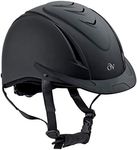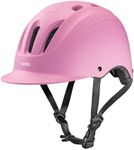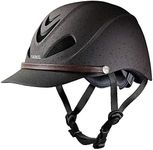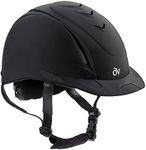Buying Guide for the Best Horse Riding Helmet For Kids
Choosing the right horse-riding helmet for kids is crucial for their safety and comfort while riding. A well-fitted helmet can protect your child from serious head injuries in case of a fall or accident. When selecting a helmet, it's important to consider several key specifications to ensure it meets safety standards and fits your child's needs. Here are the key specs to look for and how to choose the best one for your child.Safety CertificationSafety certification is a mark that indicates the helmet has been tested and meets specific safety standards. This is important because it ensures the helmet can provide adequate protection in case of an accident. Look for helmets that have certifications from recognized organizations such as ASTM, SEI, or CE. These certifications mean the helmet has passed rigorous testing. Always choose a helmet with at least one of these certifications to ensure your child's safety.
Fit and SizeThe fit and size of the helmet are crucial for both safety and comfort. A helmet that is too loose or too tight can be uncomfortable and may not provide adequate protection. Helmets usually come in different sizes, and some have adjustable features to ensure a snug fit. Measure your child's head circumference and refer to the helmet's sizing chart to find the right size. The helmet should sit level on your child's head, covering the forehead without obstructing vision, and should not move excessively when the head is shaken.
VentilationVentilation refers to the helmet's ability to allow air to flow through, keeping the rider's head cool and comfortable. This is important, especially during long rides or in hot weather, as it helps prevent overheating and discomfort. Helmets with multiple vents or channels for airflow are ideal. If your child tends to get hot easily or rides in warm climates, look for a helmet with good ventilation to ensure they stay comfortable.
WeightThe weight of the helmet can affect comfort and ease of use. A lighter helmet is generally more comfortable for kids to wear for extended periods, reducing strain on their neck and head. Helmets made from lightweight materials like polycarbonate or composite materials are a good choice. If your child will be wearing the helmet for long rides or competitions, opt for a lighter helmet to ensure they remain comfortable throughout.
AdjustabilityAdjustability features, such as adjustable straps and dial-fit systems, allow for a more customized and secure fit. This is important because it ensures the helmet stays in place and provides maximum protection. Helmets with adjustable features can also accommodate growth, making them a more versatile option. Look for helmets with easy-to-use adjustment mechanisms so you can quickly and easily achieve the perfect fit for your child.
Padding and LiningPadding and lining inside the helmet provide additional comfort and impact protection. This is important for reducing pressure points and ensuring a snug fit. Removable and washable padding is a great feature, as it allows you to keep the helmet clean and fresh. Choose a helmet with soft, moisture-wicking padding to keep your child comfortable and dry during rides.
Style and DesignWhile not as critical as safety features, the style and design of the helmet can be important for encouraging your child to wear it. A helmet that your child likes and feels good wearing is more likely to be worn consistently. Helmets come in various colors, patterns, and designs, so involve your child in the selection process to find one they are excited about. This can help ensure they wear the helmet every time they ride.























